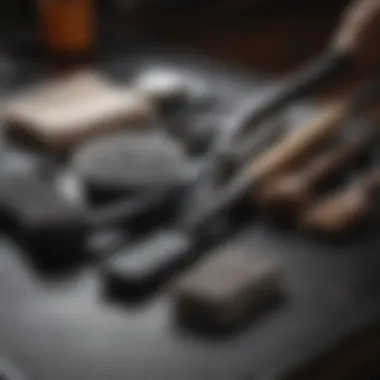Expert Tips for Cleaning Your Cast Iron Pan


Intro
Cleaning a seasoned cast iron pan is a task that requires both thoughtfulness and care. Unlike non-stick cookware, keeping the seasoning intact on cast iron is crucial for its longevity and performance. This article explores effective techniques for cleaning, emphasizes common mistakes to avoid, and highlights best practices for maintaining your treasured cookware. Understanding these aspects is essential for anyone who values quality cooking and the unique benefits of cast iron.
Caring for cast iron is not just functional; it is a commitment to a culinary tradition that enhances flavors with every use. By following the guidelines and tips provided, you can ensure that your cast iron pan remains in optimal condition for years to come.
Understanding Cast Iron Cookware
Understanding cast iron cookware is essential for anyone who wants to maintain and enjoy the benefits of this versatile kitchen tool. Cast iron pans are revered for their durability, heat retention, and even cooking capabilities. Yet, their unique characteristics require specific care techniques to ensure their longevity and effectiveness.
Characteristics of Cast Iron
Cast iron cookware stands out due to its exceptional heat retention. When properly heated, it holds heat longer than many other materials. This feature allows for even cooking, making it ideal for tasks such as searing meat or baking cornbread. Additionally, cast iron is highly durable. When treated with care, cast iron pans can last for generations. They develop a natural non-stick surface through seasoning, creating a reliable cooking surface. It is also worth noting that cast iron pans can be used on various heat sources, including gas, electric, and even open flames.
The Importance of Seasoning
Seasoning is crucial for cast iron cookware’s performance and longevity. It involves applying a thin layer of oil to the surface and heating it until the oil bonds with the metal. This process not only enhances the non-stick properties but also prevents rust. A well-seasoned pan improves the flavor of the food prepared on it, as the oils baked into the surface can impart rich, complex tastes over time. Neglecting seasoning can lead to deterioration of the cookware, making it essential for users to understand and regularly maintain this protective layer.
"Proper care and understanding of cast iron cookware can transform it into an heirloom piece that serves well for decades."
In summary, understanding cast iron cookware involves appreciating its unique characteristics and the critical role of seasoning. This knowledge equips users with the skills necessary to make the most out of their cast iron pieces, ensuring that they reap the benefits of this time-tested cookware.
Common Misconceptions About Cleaning
When it comes to cleaning seasoned cast iron cookware, many misconceptions can lead to improper care and maintenance. Understanding these myths is crucial, as they can significantly affect the longevity and performance of the pan. By clarifying these common misunderstandings, you can adopt proper cleaning methods that preserve the seasoning while ensuring the hygiene of your cookware. Avoiding these pitfalls enhances your cooking experience and ensures the integrity of your cast iron pans.
Soap and Cast Iron
One of the most pervasive myths about cleaning cast iron is the belief that soap should never be used. This notion often causes unnecessary anxiety for users who worry about stripping away the seasoning. However, this is not entirely accurate. While it is true that excessive use of soap can damage the layer of seasoning, a small amount of mild dish soap will not harm it. The key is moderation.
Using soap in limited quantities, especially if you are dealing with stubborn grease or food deposits, can be effective. Just remember to rinse thoroughly and dry the pan immediately afterward to prevent moisture accumulation. The protective seasoning is robust enough to withstand occasional soap without significant deterioration. This practice can help maintain hygiene without jeopardizing the cooking surface of your pan.
Avoiding Harsh Chemicals
Another common misconception is that all cleaning agents are equally harmful to cast iron. Many believe that any cleaning product could ruin the seasoning. Although it is important to be cautious, the reality is that harsh chemicals can indeed pose a risk. However, the emphasis should be on avoiding strong corrosive cleaners, which can degrade the non-stick surface and weaken the iron itself.
Utilizing bleach or abrasive scouring pads can lead to scratches and rust over time. Instead, opting for natural cleaning solutions, such as water and coarse salt, or non-abrasive scrubbers will effectively preserve the pan’s condition.
Pre-Cleaning Preparation
Proper pre-cleaning preparation is crucial for maintaining the integrity of a seasoned cast iron pan. By ensuring that you have everything needed before you begin, you can make the cleaning process more efficient and effective. This preparation allows you to address any specific requirements of your cookware and minimizes the risk of damaging the seasoning. Additionally, having your supplies in order can prevent mishaps, such as using incorrect methods or tools that could scratch or otherwise harm the surface of your pan.
Gather Required Supplies
Before diving into cleaning, it is important to gather the right tools and materials. The effectiveness of the cleaning methods greatly relies on this selection. Here are the key items you will need:
Soft Bristle Brush


A soft bristle brush plays a vital role in cleaning a seasoned cast iron pan. Its primary function is to remove food particles and debris without stripping away the seasoning. The key characteristic of this brush is its gentle bristles that provide thorough cleaning while preventing scratches. This makes it a popular choice for cast iron care. An unique feature is that it can reach into the pan's grooves, ensuring no residue is left behind. This brush offers a significant advantage by preserving the seasoning layer, which is essential for non-stick performance. However, it's important to use it with care; excessive pressure can still impact the seasoning.
Coarse Salt
Coarse salt is another essential item for cleaning cast iron pans. It acts as a natural abrasive, helping to lift stuck-on food without harsh scrubbing. This ingredient’s key characteristic is its size; larger granules provide effective cleaning without damaging the pan’s coating. Coarse salt is a beneficial choice in the way that it enhances the cleaning process while respecting the seasoning. The unique feature of coarse salt is its ability to absorb moisture and odors as it works. The only downside might be its limited ability to clean heavily charred surfaces; in such cases, additional methods might be required.
Oiling Cloth
An oiling cloth serves a crucial function in maintaining the seasoning after cleaning. This cloth is typically made from absorbent material that allows it to hold cooking oil effectively. Its main characteristic is its ability to evenly distribute oil over the surface of the pan, ensuring that the seasoning is renewed after cleaning. This is a popular choice because it simplifies the process of re-oiling cast iron cookware. The unique feature of an oiling cloth is its reusable nature, making it an eco-friendly option. However, care needs to be taken to ensure it is clean before use, as oiling with a dirty cloth can lead to contamination.
Cool Down the Pan
Before starting the cleaning process, it’s essential to allow the pan to cool down. Cleaning a hot cast iron pan can cause burns and also warp the metal. Ensuring a safe temperature allows you to handle the pan efficiently and reduces the risk of spillage or accidental injury. Let the pan sit for a few minutes after cooking. This small step can prevent larger issues during the cleaning process.
Cleaning Methods
Cleaning methods for cast iron are critical for maintaining the seasoning and ensuring the longevity of the pan. The right approach not only preserves the non-stick surface but also minimizes the risk of damaging the cookware’s integrity. Given that cast iron pans can last a lifetime with the right care, understanding how to effectively clean them is essential for any culinary enthusiast.
Choosing the proper cleaning method depends on the type of food residues left in the pan and the specific condition of your cast iron skillet. There are various methods available, each with its benefits and considerations. It is crucial to be informed about them to avoid common pitfalls.
Method One: Oil and Salt Scrub
Using an oil and salt scrub is an effective and simple method to clean a seasoned cast iron pan. This technique combines both abrasive and lubrication properties, making it useful for removing stuck-on food.
- Materials Needed: You will need coarse salt and a cooking oil, such as vegetable or canola oil.
- Process: Pour a generous amount of salt into the pan. Add a few drops of oil to give a bit of moisture. Use a soft bristle brush or a cloth to scrub the surface gently. The salt acts as an abrasive agent to lift the residue, while the oil helps maintain the seasoning.
- Rinse: After scrubbing, rinse the pan with warm water. Ensure all salt is washed away, but do not use soap, as it can strip the seasoning.
The salt and oil scrub is particularly helpful after cooking greasy or sticky foods. Additionally, this method can be used frequently without damaging the pan.
Method Two: Hot Water Rinse
A hot water rinse is one of the simplest ways to clean a cast iron pan, especially if the food remnants are not overly stubborn.
- Instructions: After cooking, allow the pan to cool for just a few minutes—do not let it sit for too long as this can lead to adherence. Then, run hot water over the pan while using a soft sponge or cloth to wipe away any food particles.
- Considerations: Avoid soaking the pan in water, as prolonged exposure to moisture can lead to rust. Post-rinse, promptly dry the pan using a dry cloth or by placing it on a low heat burner for a few moments.
This method is quick and efficient, suitable for daily cleaning after less messy meals.
Method Three: Baking Soda Paste
For those dealing with particularly stubborn residues or even burnt food, a baking soda paste can offer a solution without harsh chemicals.
- Preparation: Mix baking soda with a small amount of water in a bowl to create a paste that is thick enough to stick on the surface.
- Application: Apply the paste to the affected areas of the pan. Allow it to sit for 10 to 15 minutes to soften the residue. Afterward, scrub with a soft brush or cloth.
- Final Steps: Rinse the pan with warm water, ensuring the baking soda is entirely washed away. Dry the pan as mentioned in the previous methods.
Baking soda is mildly abrasive but safe for cast iron, making it an excellent choice for tough cleaning tasks without risking the pan’s integrity.
Remember: Each cleaning method serves its purpose and can be chosen based on the specific cleaning need. Proper methods yield effective results and help in maintaining the cast iron's seasoning.
Post-Cleaning Care


Post-cleaning care is a crucial step in maintaining the longevity and performance of a seasoned cast iron pan. After the cleaning process, neglecting the next stages can lead to deterioration or damage. By ensuring proper post-cleaning techniques, one can preserve the non-stick surface and enhance the overall cooking experience. The two main areas of focus in post-cleaning care are drying the pan and reapplying seasoning, both integral components to uphold the pan’s character and function.
Drying the Pan
Drying the pan promptly after cleaning prevents moisture from causing rust. It is essential to avoid air drying as this can leave behind water spots. Instead, use a clean cloth to wipe down the interior surfaces. If necessary, heat the pan on a low flame for several minutes. This helps to evaporate any remaining moisture. The goal is to ensure the pan is completely dry before proceeding to the next step of reapplying seasoning.
Reapplying Seasoning
Reapplying seasoning is vital for maintaining the protective layer that prevents food from sticking and averts rust formation. The seasoning acts as a barrier, ensuring that the pan remains functional and durable. Not only does it safeguard against the effects of moisture, but it also enhances the natural flavors of the food prepared in the cookware.
Choosing the Right Oil
Selecting an appropriate oil for seasoning is crucial. Common choices include flaxseed oil, canola oil, and vegetable oil. These options polymerize effectively, successfully forming a non-stick layer when heated. Flaxseed oil is particularly notable for its high smoking point and ability to create a robust finish. However, it can be more expensive than other oils. Canola or vegetable oil may be more affordable and provide adequate seasoning benefits. It is essential to avoid oils with low smoking points, as they can lead to a sticky residue instead of a smooth finish.
Applying Heat for Seasoning
Applying heat correctly during the seasoning process is key. After choosing the oil and applying a thin, even layer on the pan, preheat the oven to a high temperature, generally between 400°F and 450°F. This process allows the oil to bake onto the cast iron, creating a hard layer that protects as well as enhances the cookware’s characteristics. It’s advisable to flip the pan upside down in the oven to ensure accumulation of excess oil doesn’t occur. Allow the pan to bake for at least one hour, and then let it cool slowly in the oven. This gradual cooling helps ensure the integrity of the seasoning is reinforced, giving the pan a resilient finish against future wear and tear.
Investing time in post-cleaning care not only enhances cooking performance but also extends the lifespan of your seasoned cast iron pan.
Storing Your Cast Iron Pan
Proper storage of your seasoned cast iron pan is crucial in maintaining its quality and longevity. This step is often overlooked, yet it plays a significant role in the overall care of the cookware. An improperly stored cast iron pan can become susceptible to rust, damage, and deterioration of its seasoning. Therefore, understanding the best practices for storing your pan is essential for any cast iron user.
Avoiding Moisture
Moisture is one of the primary enemies of cast iron. When water remains on the surface of the pan or in the storage area, it promotes rust formation. To avoid this, ensure your pan is completely dry after cleaning.
Here are some considerations:
- Wipe the Pan Thoroughly: After cleaning, use a dry cloth or paper towel to wipe down your cast iron pan. Pay attention to any corners or crevices where moisture can linger.
- Heat the Pan Lightly: You can place the pan on low heat for a few minutes. This helps evaporate any remaining moisture that might not be visible.
- Use a Light Coating of Oil: Once dry, apply a thin layer of cooking oil over the surface. This not only prevents moisture from settling but also helps to maintain its seasoning.
It's important to regularly check the storage area for any signs of moisture, especially if you live in a humid climate.
Proper Stacking Techniques
When it comes to stacking cast iron pans or placing them in a cupboard, care must be taken to avoid unnecessary scratching of the seasoning. Here are effective stacking techniques:
- Place Fabric Between Pans: Use a cloth or paper towel between stacked pans to minimize friction. This will protect the surface and keep the seasoning intact.
- Avoid Direct Contact with Other Cookware: If possible, avoid stacking your cast iron pan with other cookware that may also scratch or damage its surface.
- Store in a Cool, Dry Place: Ensure your storage area is dry and cool. Avoid placing the pan near heat sources or in damp areas
Proper storage can prolong the life and cooking efficiency of your cast iron pan, allowing it to serve you well for generations.
Implementing these practices will ensure your cast iron pan remains in optimal condition. Remember, a well-cared-for cast iron pan can improve with age, enhancing your cooking experience.
Troubleshooting Common Issues
Cleaning and maintaining a seasoned cast iron pan can pose challenges, even for the most diligent users. In this section, we will discuss common issues that can arise in the process and how to resolve them. Addressing these problems is essential for preserving the quality and longevity of your cookware. Ignoring them can lead to permanent damage or diminished cooking performance.
Understanding these challenges allows users to engage more effectively with their cast iron, ensuring a safe cooking surface and enhancing the pan’s natural non-stick properties.


Dealing with Rust
Rust on cast iron pans develops primarily due to moisture exposure. Even slight amounts of water lingering on the surface can initiate this process, leading to unsightly marks and potential degradation. It is crucial to address rust immediately, as it can worsen over time and affect the overall functionality of the pan.
To remove rust, begin by gently scrubbing the affected area with a fine-grade steel wool pad or a non-metallic abrasive pad to avoid further scratches on the pan’s surface. After removing the rust, wash the pan using hot water and mild soap if necessary, though keep soap use minimal to protect the seasoning. Rinse thoroughly and dry completely with a clean cloth or paper towel to prevent further moisture accumulation.
Once dry, reapply a very thin layer of vegetable oil or another suitable oil to restore the seasoning. Place the pan in an oven set to a low temperature for about one hour to help the oil bond. By following these steps, you can effectively eliminate rust and maintain the beauty of your cast iron.
Removing Stubborn Residue
Stubborn residue poses another challenge when cleaning a cast iron pan. Often, food remnants may cling persistently even after regular washing, leading to dissatisfaction in the cooking process. To tackle this problem, utilize gentle yet effective methods.
One recommended technique is to create a paste using equal parts baking soda and water. Apply the paste to the residue and let it sit for several minutes to loosen the particles. Afterward, scrub softly with a soft bristle brush or non-abrasive sponge. If necessary, rinse and repeat until the residue is fully removed.
It is important to note that while some tools can aid in removal, avoid anything too abrasive that might strip away the seasoning. Patience during the cleaning process is key. Implementing these strategies will ensure your cast iron pan remains pristine and continues to age gracefully.
Maintaining Your Cast Iron Cookware
Maintaining your cast iron cookware is crucial for ensuring its longevity and performance in the kitchen. Unlike some other types of cookware, cast iron requires specific care to maintain its distinctive qualities. A well-maintained cast iron pan can serve you faithfully for many years, even generations. Regular care not only prevents deterioration but also enhances the cooking experience, contributing to better flavors and healthier meals.
The key aspects of maintaining cast iron include regular cleaning, proper seasoning, and mindful storage practices. Each element plays a role in keeping the cookware in optimal condition. Furthermore, neglecting these maintenance routines can lead to issues such as rust or loss of non-stick properties, which could ultimately decrease the pan's usability.
By investing time and care into your cast iron, you maximize its benefits. This means enjoying delicious meals with a cookware that improves with age, rather than being burdened with frequent replacements or repairs. Understanding the importance of maintaining your cast iron is fundamental.
Regular Maintenance Routines
Maintaining your cast iron cookware involves a few key routines that should be integrated into your culinary practices. Here are some recommended tasks:
- Daily Cleaning: After each use, clean your pan with hot water and a soft sponge. Avoid soap unless necessary, as soap can strip seasoning.
- Dry Thoroughly: After washing, always dry your pan completely to prevent moisture-induced rust.
- Oil Lightly: After drying, apply a thin layer of vegetable oil or flaxseed oil to maintain the seasoning and protect against moisture.
These routines can help ensure that your cast iron remains dependable.
Enhancements Over Time
Enhancing your cast iron cookware through seasoning is vital. Over the years, with consistent seasoning maintenance, your pan will develop a natural non-stick surface that gets better with each use. Here's how to enhance your cast iron:
- Enhance with New Layers: Whenever you cook with oil, you contribute to the seasoning. Techniques such as frying or sautéing build the seasoned layer.
- Avoid Abrasive Scrubbing: When cleaning, remember that a rough scrubbing can damage your seasoning layer. Gentle methods preserve and enhance what you've created.
- Consider Re-seasoning: If you notice any sticky spots or if your cookware has lost its sheen, re-seasoning it can restore its function.
Investing time in these enhancement practices will ensure that your cast iron remains functional and continues to improve, adapting to your cooking style over time.
Closure
Cleaning a seasoned cast iron pan is an essential routine that every cast iron cookware user should understand. This process not only ensures the hygiene of the cookware but also preserves the non-stick quality derived from the seasoning. Several key points from the article emphasize the need to avoid harsh chemicals and the ill effects of improper cleaning methods.
By learning the right techniques, such as using oil and salt scrubs or hot water rinses, one can maintain and enhance the performance of the pan without damaging its precious seasoning layer. It is critical to appreciate that the longevity of cast iron pans relies heavily on how well they are cleaned and maintained post-cooking.
Take care with moisture when storing your cookware, as it can lead to rusting and other issues. Additionally, being aware of common pitfalls, like applying soap, helps in extending the life of a cast-iron pan considerably.
In summary, a solid conclusion of this guide lies in understanding that the care routines for cast iron require time and knowledge. Implementing the best practices mentioned throughout the article allows users to enjoy the full benefits of their cast iron cookware consistently. This not only enhances their cooking experience but also fosters a deeper connection with a material that has stood the test of time in kitchens around the world.
"The cycle of proper cleaning, seasoning, and maintenance is key to preserving the rich legacy and functionality of cast iron cookware."
Whether you are new to cooking or an experienced chef, paying attention to the simple steps outlined ensures that your seasoned cast iron pan remains a reliable tool in your kitchen for many years.



